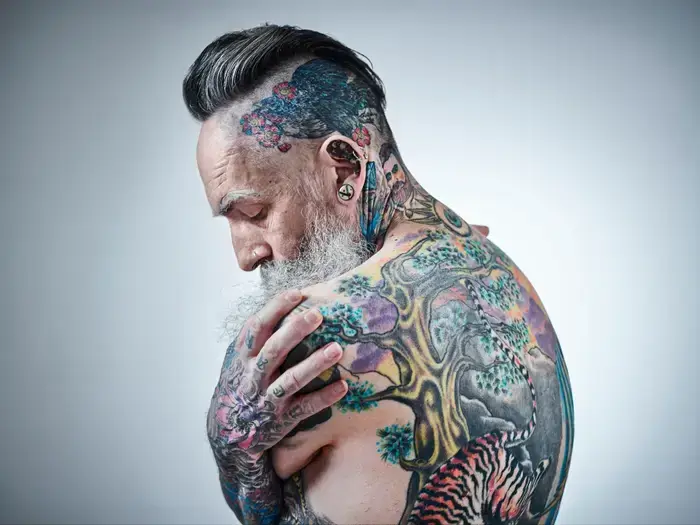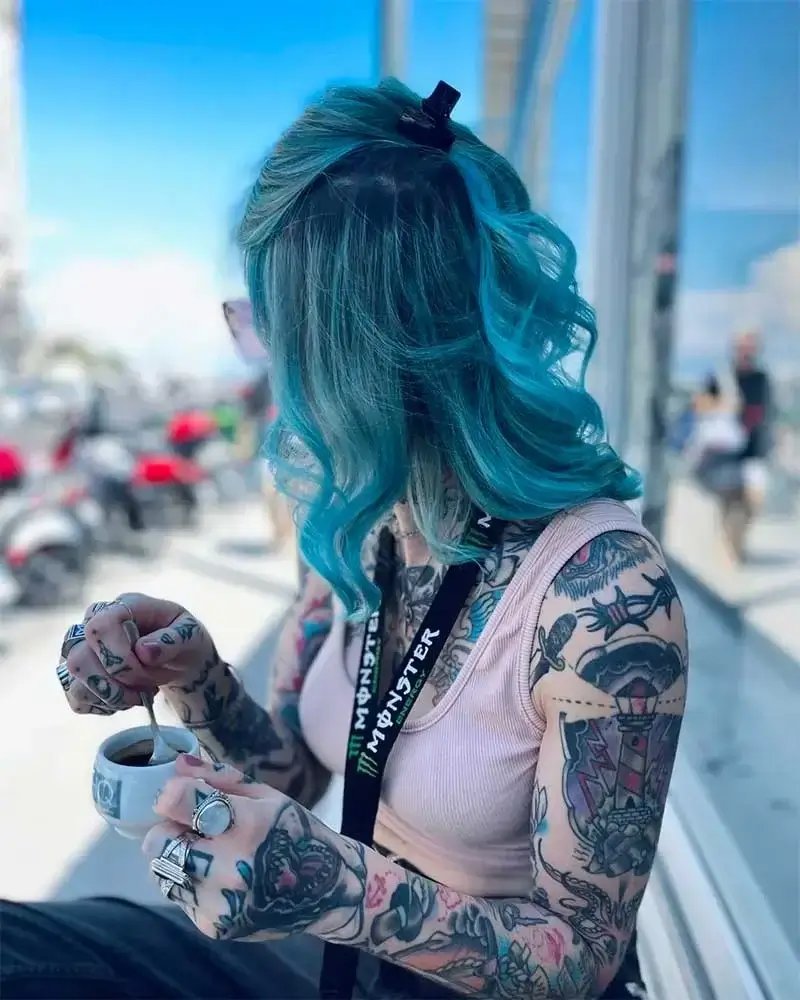In the world of body art, the question of “what is considered heavily tattooed” often sparks a blend of fascination and curiosity.
Historically, tattoos, dating back to 3000 B.C., were a practice to identify criminals or enslaved people, but today, they tell a different story.
For many, starting from their early teens and progressing into their early 20s, tattoos become a form of self-expression.
A person with two or more tattoos, where elaborate designs and patterns permanently or temporarily adorn significant portions of their skin, is typically considered heavily tattooed.
Whether through colorful or black tattoo ink, each tattoo serves as a canvas to express passions, portray personal evolutions, and narrate life stories, reflecting a journey from simple fascination to profound self-confidence.
Also Read: How Many Tattoos Is A Lot
Concept Of Heavily Tattooed
In the cultural and social concepts of body art, being heavily tattooed often involves having heavy tattoo coverage, especially in visible areas like the neck and face.
This visibility can evoke varied reactions from society, ranging from admiration to objections.
Within heavily tattooed communities, these perceptions are deeply intertwined with identity and self-expression.
What Is Considered Heavy Tattoo?
To add and clarify the whole concept of what constitutes heavy tattoos, it’s not just about the tattoo numbers; it’s about how they define the human body.
Being heavily tattooed doesn’t hinge solely on having numerous miniature tattoos. It’s more about their size, placement, and how much of the body a single tattoo covers.
For instance, a tattoo that covers over fifty percent of a body part is more significant than one covering only ten to twenty percent.
However, last but not least, it’s about personal preference and individual style. Different people have different concepts of what constitutes a heavy tattoo, whether it’s a half-sleeve or more extensive pieces.
While opinions may vary, at the end of the day, it’s about what someone might think is considered heavily tattooed.
Also Read: How Many Tattoos Is A Lot For A Woman
What Are The Reason Behind Choosing A Heavy Tattoo?
Major reasons for choosing a heavy tattoo intertwine historical and cultural reasons with spiritual and religious reasons, alongside social and individual motivations.
1. Historical & Cultural Reason
The historical and cultural reasons behind heavy tattoos are deeply rooted in ancient culture, with each culture having its particular reasons for body art.
In many societies, men’s legs were decorated as a rite of passage, a practice echoed in the Dai proverb that “a man without tattoos is invisible.”
This significance is evident in various Tribes where an old-age tradition of body art symbolized status and achievements.
For instance, among some Asian cultures, tattoos were used to identify a person’s caste or criminality.
In the case of indigenous people like the Kankanaey, arms, chest, and face tattoos, such as the Chacklag tattoos of Bontoc warriors in the Philippines, were markers of prestige or bravery.
Similarly, Maori tribes in New Zealand have a rich tattoo history, where their intricate designs, stemming from the Tahitian word ‘tattau’ meaning to strike or tap, often indicated social rank and ancestry.
During the late 19th century, circus women, known as tattooed ladies, began to display their faces, arms, hands, and necks – all visible areas – in circuses and entertainment sectors, showcasing an interesting fact that heavy tattoo became popular beyond its traditional roots.
This tradition and its impact in modern times reflect the evolving perception and acceptance of heavily tattooed individuals across various cultures.
Also Read: Can I Take Gabapentin Before A Tattoo? Here’s What Experts Say
2. Spiritual & Religious Reasons
For many people, the practice of tattoo making goes beyond mere social and cultural aspects, delving into spiritual and religious significance.
It’s hard to deny the influence of various philosophies and religions on this art form. In the realm of spirituality and life, religious tattoos have become popular, often used to symbolize devotion or divine protection.
Different religions offer significant symbolizations; for instance, Buddhism embraces tattoos of the Bodhi tree, representing enlightenment, while Christianity might favor symbols like the anchor, cross, or dove, representing hope, eternal love, or the holy spirit.
Similarly, Hinduism reveres the Om symbol, and Judaism values subtle references to its rich heritage.
These symbols, whether depicting water, infinity, wings, or the yin and yang, make a profound impact on an individual’s spirituality.
Being heavily tattooed often carries a depth of meaning, reflecting a person’s philosophically driven journey through life.
Also Read: Can Tattoos Cause Blood Cancer
3. Social & Individual Reason
The influence of heavy tattoos in social and individual life cannot be understated.
A striking description of this is Vladimír Franz, a heavily tattooed candidate in the 2013 Czech presidential election, whose nearly body tattooed appearance was a bold expression of free will.
This highlights the social reasons individuals might choose heavy tattoos: sometimes it’s about increasing social awareness, reminding others of a tragic phenomenon, cherishing national memory, or paying tribute.
Such actions by National Level Influencers demonstrate the profound social impact of tattoos.
From an individual perspective, the reasons for choosing heavy tattoos are manifold.
They can create a statement to the world, involve the risks and thrill of self-expression, or be a way to forge a unique identity.
For many, a heavily tattooed person may use their art to improve self-esteem, challenging how society views their roles.
These important social people often pave the way for broader acceptance and understanding of heavily tattooed individuals.
Also Read: Optimize Tattoo Aftercare: Is Dial Gold Good For Tattoos?
The Evolution Of Tattoo
The evolution of the heavy tattoo reflects a rich tapestry of history and culture.
Initially, women in various societies used tattoos for diverse reasons, like Royal concubines, dancing girls, and prostitutes marking stages in life or status.
In the ancient period, both Roman and Greek cultures practiced tattooing as a form of beauty and religion, with significant symbolization.
Moving to the United States, native Americans witnessed a tattoo evolution since the pre-colonial period, where their ancestors used tattoos in warfare, transitioning through the colonial period with Europeans influencing the art and ideology over time.
In modern times, tattoos have become a thriving business, with enthusiasts and artists operating in parlors across increasingly liberal and accepting societies.
This shift has led to heavily tattooed individuals across generations of human beings, with tattoos symbolizing everything from spirituality and love to gratitude and individuality, each imbued with unique energy.
Also Read: Tattoo Troubles? Demystifying Little Bumps On Tattoo After Healed

Perception Towards Heaviness In Tattoos
The perception of heaviness in tattoos, particularly when heavily tattooed areas are highly visible, such as the neck and face, often elicits negative reactions from people. Yet, one cannot deny the rising acceptance of body freedom.
While challenges persist in settings like the workplace or family parties, there’s a growing recognition of the history and importance of tattoos in society, which was once neglected.
This shift has bolstered confidence among the tattooed, even in workplaces or during a serious meeting.
The perception of tattoos varies significantly by place and country, with some embracing the positivity and others still grappling with negativity and bias.
Also Read: What Happens If You Use Scented Soap On A Tattoo
FAQs About What Is Considered Heavily Tattooed
1. Why Do People Get Heavily Tattooed?
People get heavily tattooed to show the world something they are proud of. It’s a way to improve self-esteem, embracing their bodies as a form of art and personal statement.
2. What Kind Of People Has A Lot Of Tattoos?
Both men and women, particularly those in their 20s and 30s, are increasingly embracing tattoos. There’s no age limit; even individuals over 40 are actively participating in this trend.
3. How Does Society View Tattoos?
Society is gradually shifting its perspective on heavily tattooed personalities, moving from superstitions to acceptance. Tattoos are becoming mainstream, with a growing acknowledgment of their significance and artistry.
Final Thoughts
In summary, “what is considered heavily tattooed” has evolved significantly over time.
In this modern era, heavy tattoos have become a powerful form of self-expression, reflecting changes in society and advancements in technology.
They are a canvas for unsaid feelings and emotions, enhancing self-confidence and allowing individuals to decorate their bodies in ways that were once suppressed.
